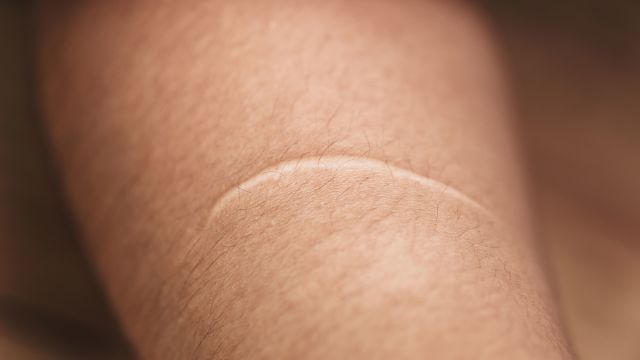Updated on May 11, 2023.
Whether it’s the result of a minor kitchen mishap or a more serious accident, almost everyone has at least a scar or two. But while some injuries seem to heal without any long-term evidence of an incident, others are permanent mementos.
The difference is often a result of the healing process, according to Evan Rieder, MD, assistant professor in the Ronald O. Perelman Department of Dermatology at NYU Langone Health in New York City. The good news is there are treatments that can minimize their appearance—and even a few at-home remedies that can help.
Why scars form
Any wound that breaks the skin has potential for scarring, says Dr. Rieder. So, even scraping your knee or getting acne could result in blemishes. At first, your wound will become inflamed; it's a natural response that may last a few days and promotes blood circulation to the area, which helps it heal faster. At the same time, skin cells and a protein called collagen work to fill the gap produced by the trauma.
Once the “new skin” is in place, it goes through a process of maturation, Rieder notes. It will start to re-pigment—change color from an initial tone to one closer to your own skin color. The collagen can also have a different composition than the original skin, with less elasticity. For those who have a scar forming, this can feel like tightness around the wound area, as well as hardness to the scar itself, since the new tissue is denser than the tissue it's replacing.
What affects a scar's shape and color
People with high levels of melanin—a natural brown pigment in the hair, skin, and iris of the eye—such as people of either African or Asian ancestry, are more likely to develop darker scars, Rieder says. Other factors determining the color include the shape of the wound, its location on the body, and whether the healing skin is exposed to too much sunlight.
As for shape, “a wide wound will take longer to heal and that will likely result in a major scar because the skin can’t repair itself in the most efficient way,” adds Rieder. If the body makes an excess of extra tissue for the wound, the scar will be higher than the surrounding skin; this raised scar can be a keloid or a hypertrophic scar. A keloid will continue growing past the boundaries of the wound, while a hypertrophic scar will typically shrink over time. If a wound causes high levels of inflammation—like acne does—that might destroy the collagen in the skin, resulting in a sunken scar that’s below the surrounding skin level.
Dermatologist treatments
Some types of scars fade with time, but for those that are bothersome or painful, or restrict movement in some way, treatment may help. Dermatologists can use lasers and light treatments to reduce a scar's discoloration. They can also break down some of the excess collagen that tightens the skin and can lead to raised scars. Your healthcare provider may use injections of steroids to soften the scar tissue and minimize pain and itching, as well.
If a scar is limiting movement—especially in the muscles and joints—treatment will center on reducing scar contracture, Rieder says. He notes that this treatment is common in veterans' facilities for combat injuries affecting range of motion and functional mobility.
At-home treatments and remedies
There’s no over-the-counter treatment that will magically make your scars disappear, but for more minor scars, silicone gel sheets can be effective for reducing discoloration, swelling, and irritation, Rieder notes. The sheets are self-adhesive, and best used on newer wounds or scars.
One of the best treatments to keep existing scars from getting more noticeable is sunscreen, Rieder recommends. Scars are more sensitive to damage from UV rays, he notes, and that can change a scar’s color and appearance. “Sunscreen is the best anti-aging medicine on the planet,” he says. “That applies to your scars, too.”
For many people—if not all—scars are inevitable, especially if you work or serve in professions where major and minor injuries are a frequent hazard. But treatment may help to reduce their appearance and especially their impact, so you can get back more movement and function.







